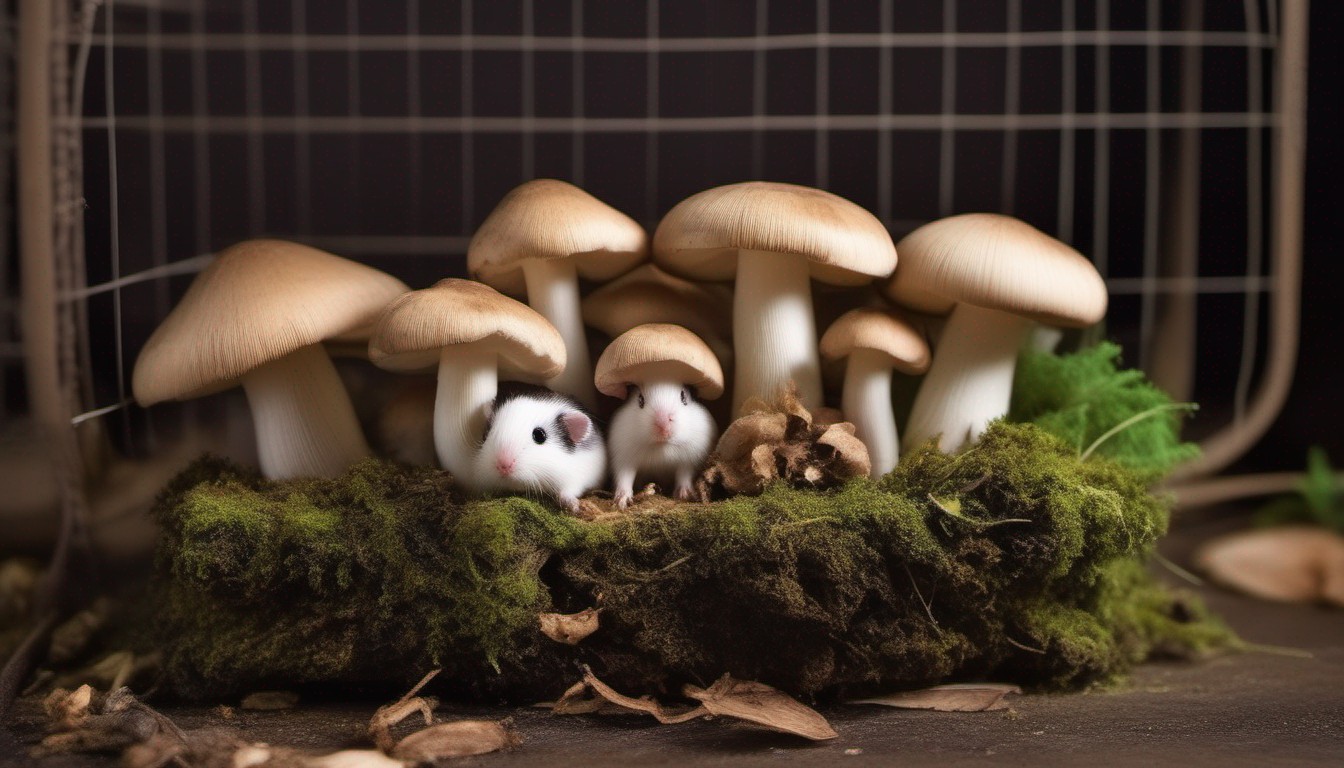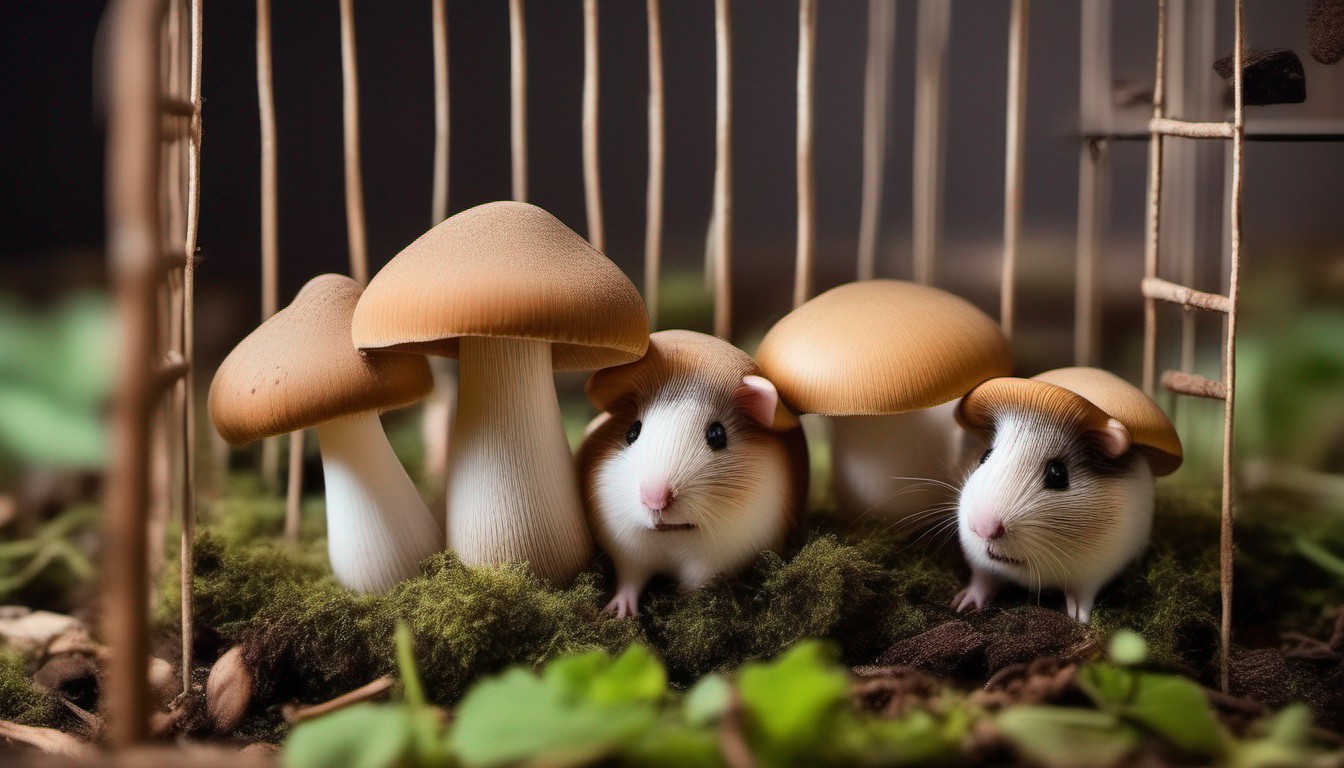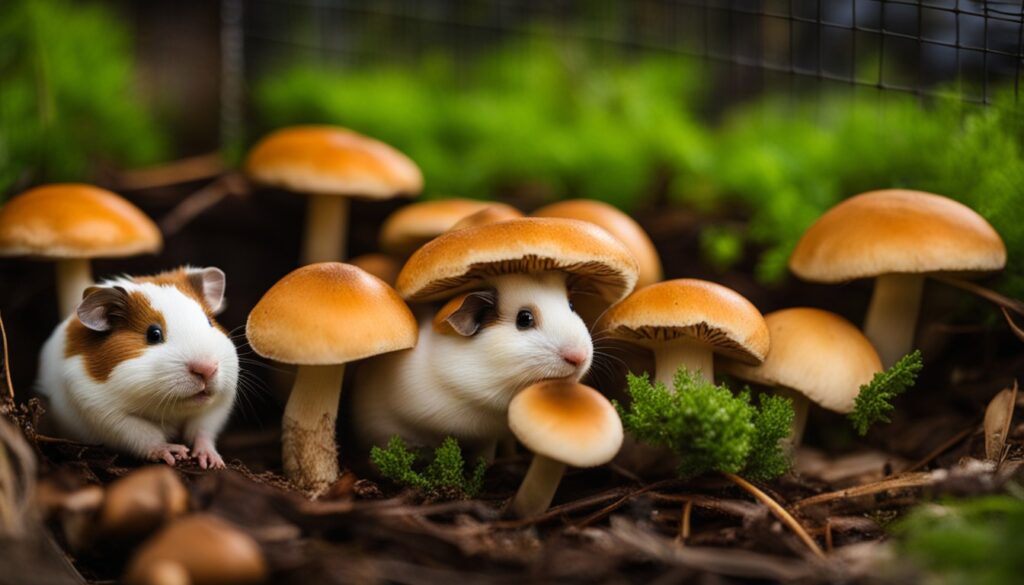When it comes to your guinea pig’s safety, taking proactive measures to prevent the growth of mushrooms in their cage is essential. One effective approach is to regularly clean and sanitize the cage, removing any organic matter that could potentially harbor fungal growth. Additionally, monitoring the humidity levels in the environment can help prevent the conditions that promote mushroom growth. Implementing proper ventilation and ensuring adequate air circulation can also play a vital role in maintaining a fungi-free environment. By following these practical steps, you can create a safe, hygienic space for your guinea pig and minimize the risks associated with mushrooms in their cage.
Why Are Mushrooms a Concern in Guinea Pig Cages?
Despite it being an unusual concern, the presence of fungi in a guinea pig’s habitat is a matter of great importance. This small oversight can lead to severe health implications not always visible to the untrained eye.
Being able to spot signs of mushroom contamination in your pet’s enclosed space is crucial. Mushrooms, considered toxic for these tiny creatures, can trigger unwanted health issues, thus impacting their overall well-being.
Understanding the Risks
Mushroom growth within guinea pig cages can present a series of unwelcome hazards. It’s important to note that not all types are harmful; nonetheless, the risks of ingestion or exposure to toxic strata sufficiently necessitate concern.
Toxic mushrooms in guinea pig cages can severely affect pet health, inducing digestive disorders and respiratory issues; emphasizing the importance of cage hygiene and risk awareness.
Beyond detrimental impact on general cage hygiene, certain fungi are capable of inducing health afflictions in guinea pigs—ranging from digestive disorders to more severe respiratory issues. Hence, understanding the ways in which these threats manifest, is of paramount relevance for the wellbeing of your pet.
Health Issues
Keeping a guinea pig’s habitat clean is directly tied to its health. The presence of mushrooms indicates unhygienic conditions, potentially leading to a host of health issues in your pet.
Exposure to fungi, like those found in mushrooms, can result in a variety of health disorders in guinea pigs. Respiratory distress, skin irritation, or even systematic fungal infections may be ramifications of such crude living conditions.
Potential Dangers for Guinea Pigs
Mushrooms in a guinea pig’s cage are more than an unsightly nuisance; they can pose serious health risks. Toxic compounds within certain fungi can cause allergic reactions and even coma or death in guinea pigs.
Mushrooms harbor numerous species of mold and bacteria, creating an unhealthy environment. These conditions can lead to respiratory distress, skin infections, and systemic fungal disease in guinea pigs.
The production and distribution of fungal spores, a common feature of mushrooms, pose an additional invisible threat. These spores can be inhaled by your pet leading to breathing difficulties, lung damage, and other health ailments.
Guinea pigs, due to their close proximity to the ground, are susceptible to inhaling these hazardous spores. This not only increases the chances of respiratory diseases but could also potentially lead to a fatal condition termed ‘fungal pneumonia’.
Identifying and Preventing Mushroom Growth

The best approach to thwarting mushroom expansion within guinea pig enclosures lies in vigilance and preemptive action. By regularly examining the cage, you can identify early signs of mushroom blooms, taking effective steps to curb their growth before they become a health hazard.
Becoming well-versed with ‘Fungi Busters’ – techniques designed to identify and prevent mushroom growth is imperative for guinea pig caregivers. This includes understanding the conditions that support mushrooms, spotting their presence early, and implementing robust cleaning procedures to ensure safe and fungi-free living quarters for your cherished pet.
Common Types of Mushrooms in Guinea Pig Cages
When it comes to popular pets like guinea pigs, awareness about potential fungal threats in their cages is crucial. This is especially true for mushrooms, which exhibit diversity and pose health risks for these small animals.
- Spot the whitish or yellowish umbrella-like structures of the Agaricus species
- Identify flat or funnel-shaped fungi, such as the Clitocybe species
- Being aware of the Phallus impudicus, characterized by its putrid smell and egg-like appearance
- Acknowledge the distinctive appearance of Amanita species, showcasing vibrant colors but posing potential toxicity
Signs of Mushroom Infestation
Being aware of possible threats is crucial in pet care. Detecting danger in guinea pig environments involves looking out for signs of fungal or mushroom growth, such as a strong musty odor, visible mushrooms or spores, or unusual damp spots.
Understanding these red flags helps provide a safer space for your pet. Also, be observant of your pet’s behavior. If they engage in excessive scratching, display signs of discomfort, or changes in eating habits, it may indicate the presence of mushrooms in their habitat.
Factors That Promote Mushroom Growth
Mushroom proliferation in guinea pig cages is facilitated by several conditions including poor ventilation, high humidity, and excess organic material. These factors create a perfect breeding ground for fungi, allowing their swift multiplication.
Environmental factors play a vital role in mushroom growth, primarily by providing sustenance and a conducive atmosphere. Spores thrive in damp, dark places and on decaying matter, thus unchecked moisture and leftover food residues can trigger a mushroom bloom.
Furthermore, the absence of regular cleaning and cage maintenance directly contributes to mushroom infestation. Unsavory elements such as moldy hay, stagnant water, and unremoved excreta too can result in a fungal outbreak, adversely affecting guinea pig health.
Effectively Removing Mushrooms
To guarantee a mushroom-free environment within a guinea pig cage, a few robust protocols can be implemented. Aimed at completely eradicating fungi, these practices comprise proven methods ensuring safety and cleanliness.
- Identify and dispose of any visible mushrooms.
- Scrub the cage thoroughly with a pet safe disinfectant.
- Remove and replace old bedding with fresh supplies.
- Sanitize food and water bowls regularly.
- Ensure accurate humidity control to mitigate fungal growth.
Creating a Fungi-Free Environment for Your Guinea Pig

When aiming to create a fungi-free environment for guinea pigs, transforming their habitats using a methodical and guided approach is vital. Meticulously eliminating every risk factor for mushroom growth helps ensure the exceptional health of your pet.
For a fungi-free future, the requisites go beyond merely ridding the enclosure of present mushrooms, and extend to maintaining a consistently sterile space. Continual vigilance and periodic checks and adjustments are the keys to providing a safe, mushroom-free environment for your guinea pig.
Proper Cage Maintenance
Routine cage cleaning is essential in preventing the growth of harmful fungi. By removing food particles and waste regularly, you limit the organic material available for fungi to thrive on.
It’s worth noting that overcleaning can promote mushroom spores. Complete sterilization destroys beneficial microbes that control the fungal population, creating an environment conducive to mushroom growth.
In maintaining the cage, a balance should be struck between scrupulous cleanliness and allowing a degree of bacterial activity. Neglecting either aspect might lead to a fungal outbreak.
For effective cage maintenance, adopt a routine cleaning schedule. Daily spot cleaning, coupled with a deep cleaning once a week, helps maintain a healthy cage environment.
Additionally, ensure all accessories such as toys, bowls, and hideouts are thoroughly cleaned during the deep cleaning process. This prevents lingering spores from starting a new colony.
Importance of Good Ventilation
Adequate ventilation proves crucial in abating mushroom growth in guinea pig cages as it lowers humidity levels, fosters drier conditions, and diminishes the propensity for fungal spores to thrive. It inherently alters the environment, hindering the conducive conditions that fungi often leverage.
Ventilation serves as a two-edged sword—it doesn’t only ward off fungi, but also improves the overall health of your guinea pigs. The appropriate airflow reduces stale odors often associated with bacteria, thus shoring up respiratory health among these delicate rodents.
Furthermore, a good flow of air eliminates excess heat, reducing the risk of heat-stroke and promoting an overall comfortable and stress-free existence for your guinea pigs. After all, a placid pet promises a more rewarding companionship.
Choosing the Right Bedding
When it comes to deterring fungi formation in your guinea pig’s cage, nothing is more important than the bedding you choose. Opt for highly absorbent materials, such as paper or aspen shavings, which can quickly sop up urine and excess moisture, discouraging mushroom growth.
Antimicrobial bedding is an investment worth considering. This type of material is treated with agents that prevent fungi, bacteria, and other microorganisms from thriving.
Although the initial cost may be higher than standard bedding, the peace of mind and potential vet bills saved from avoiding health issues related to fungi may outweigh the expense.
Remember, change the bedding regularly, regardless of its properties, as it is part and parcel of maintaining a healthy and fungi-free habitat for your guinea pig.
Controlling Humidity Levels
Achieving the right balance of humidity in a guinea pig cage is crucial. Excessive humidity creates a suitable environment for mushroom infestation while too little can hamper guinea pigs’ health. Hence, a strategic plan is necessary for humidity regulation.
A digital hygrometer provides a practical solution to this humidity conundrum. This device allows pet owners to measure and monitor the relative humidity levels within the cage, ensuring they are within the recommended range of 30-50%.
Periodic checks with the hygrometer can help in quick identification of any spike in humidity levels, facilitating immediate corrective action. It serves as an early warning system for any potential mushroom growth.
Once you identify higher than optimal humidity levels, you can intervene accordingly. A low wattage heat bulb or a humidity absorber can help lower the moisture content within the cage, thereby preventing mushroom infestation.
Embracing suitable technology for monitoring and controlling cage humidity is recommended. A proactive approach in maintaining suitable humidity levels can ensure a fungi-free environment for your guinea pig.
Taking Precautions with Food and Water

A balanced diet for guinea pigs, focusing on quality and not quantity, contributes to a fungi-free environment. Healthy, uncontaminated food diminishes the likelihood of mushroom growth in their cages.
Guinea pigs, much like humans, benefit greatly from clean water. Ensuring your pet’s water supply is uncontaminated inhibits mushroom development in its vicinity, thereby promoting a healthier habitat.
Avoiding Contaminated Hay
Steer clear of the hidden dangers of mushroom spores lurking in contaminated hay. These spores often travel and proliferate, imposing serious health hazards on your cute little companions.
Ditch traditional hay in favor of risk-free alternatives like wheatgrass. Not only does it minimize the chance of mushroom contamination, but it also provides the essential fiber that guinea pigs require for a thriving life!
Cleaning and Disinfecting Food Bowls
Optimal cleaning techniques play a key role in retaining a fungus-free food bowl for your guinea pig. Regular, thorough cleaning eliminates spores, mentreventing premature decay of leftover food help to deter the growth of unseen microorganisms.
Particularly, disinfectants become a layer of defense against fungi, creating a safer eating environment for guinea pigs. Using pet-friendly, non-toxic disinfectants guarantees the elimination of harmful fungi, while assuring the well-being of your guinea pig.
Preventing Water Spills
Inevitably, untreated water spills breed a moist environment conducive to mushroom growth in guinea pig habitats. Even puddles hidden under bedding hold the capacity to activate dormant fungus spores, making awareness and swift action essential. Such a damp setting puts your pet on a potentially perilous path with fungal threats lurking beneath the surface.
Addressing the concern begins with prevention. Innovative solutions range from non-spill water bowls to drip-resistant water bottles specifically designed for small pets. Both can significantly reduce the chances of water spills, ensuring a dry environment less prone to mushroom proliferation.
Constant monitoring allows for swift identification and rectification of spills, effectively nipping the mushroom problem in the bud before it spirals out of control. From regular cage cleaning schedules to immediate spot cleaning post-spills, equipping oneself with preventive measures helps safeguard the health and well-being of your guinea pig.
Monitoring Fresh Vegetables and Fruits
Despite their nutritious value, fresh vegetables and fruits pose a hidden peril to guinea pigs, potentially carrying fungi spores. Careful selection, thorough washing, and prompt removal of leftovers help to prevent any inadvertent mushroom growth in the cage.
Safe storage practices, including rotation techniques, are essential in preventing fungi development. Keeping fresh produce in cool, dry environments, away from dampness-preserving materials, alongside timely practice of replacing old stock with new, ensure a fungi-free environment for your pet.
FAQ: Mitigating Risks of Mushrooms in Guinea Pig Cages
Mushrooms in guinea pig cages can pose potential risks to the health and safety of your pet. Here are some frequently asked questions and their brief answers to help you create a safe and hygienic environment for your guinea pig:
Q1: Can mushrooms in a guinea pig cage be harmful to my pet?
Mushrooms in a guinea pig cage can be toxic and potentially harmful if ingested. It is important to take preventive measures to minimize the risks. Some mushrooms are known to cause digestive issues, liver damage, or even be deadly to guinea pigs.
Q2: How can I prevent mushrooms from growing in my guinea pig’s cage?
To prevent mushroom growth, practice regular cage cleaning and sanitation, removing any organic matter that could serve as a substrate for fungi. Scrub the cage with a mild disinfectant and rinse thoroughly. Monitor humidity levels and ensure proper ventilation to reduce favorable conditions for mushroom growth. Consider using a substrate material that discourages fungi growth, such as fleece liners or paper bedding.
Q3: What should I do if I find mushrooms in my guinea pig’s cage?
If you discover mushrooms in your guinea pig’s cage, it is crucial to remove them promptly and thoroughly. Use gloves to protect yourself from potential toxins, clean the affected area with a pet-safe disinfectant, and dispose of the mushrooms in a sealed bag. Inspect the cage thoroughly for any remaining mushrooms to prevent their regrowth.
Q4: Are there any safe alternatives to mushrooms for guinea pigs to play with or chew on?
Yes, there are plenty of safe and enriching alternatives for guinea pigs to play with and chew on. Provide them with chew toys made of safe materials like untreated wood or woven grass. Offer a variety of hay for them to chew on, and include safe vegetables and fruits in their diet, such as parsley, carrots, or apple slices, under appropriate portion control.
Q5: Should I consult a veterinarian if my guinea pig has ingested mushrooms?
Yes, if your guinea pig has ingested mushrooms or shows any signs of illness after exposure, it is essential to seek veterinary advice immediately. Some symptoms of mushroom toxicity in guinea pigs include drooling, diarrhea, lethargy, or disorientation. A veterinarian can provide proper guidance and necessary treatment if needed.
Remember, creating a safe and fungi-free environment for your guinea pig is vital for their well-being. By following these preventive measures and providing appropriate alternatives for their play and chew needs, you can keep your guinea pig safe and healthy.
Conclusion
Ensuring a mushroom-free environment for your guinea pig requires comprehension of the risks, vigilant observation, and proactive measures. From understanding fungi reproduction to recognizing signs of infestation, the application of our strategies safeguards your pet’s health.
Translating theory into practice, maintaining a fungi-free cage encompasses regular cage cleaning, adequate ventilation, careful selection of bedding, and stringent humidity control – all essential elements contributing to an optimal habitat for your guinea pig.
- Guinea Pig Mushrooms Recap: Risk understanding, Infestation signs recognition, and Proactive measures application
- Guinea Pig Environment Practical Tips: Cage Regular Cleaning, Adequate Ventilation, Careful Bedding Selection, and Stringent Humidity Control.

